Meta started rolling out Advantage targeting in 2021, allowing the ads algorithm to expand your chosen targeted audienceThis is the group of people who can potentially see your ads. You help influence this by adjusting age, gender, location, detailed targeting (interests and behaviors), custom audiences, and more. More in certain situations. How and when expansion works is still often misunderstood.
It makes sense why. This topic has been a moving target.
In just two years, of course, three different Advantage targeting products with expansion capabilities have rolled out (and a confusing fourth on the horizon). It doesn’t help that the names and rules for how they’re used have evolved during that time.
Let’s clear up the confusion now…
Advantage Detailed TargetingWhen turned on, Meta can expand your audience to reach people beyond the Detailed Targeting (interests and behaviors) that you selected, but only if that expansion is expected to lead to better results. Location, age, gender, and exclusions are hard constraints, and the expanded audience will continue to follow those rules. More
Originally announced as Detailed Targeting Expansion, Advantage Detailed Targeting was the first audience expansion product available.
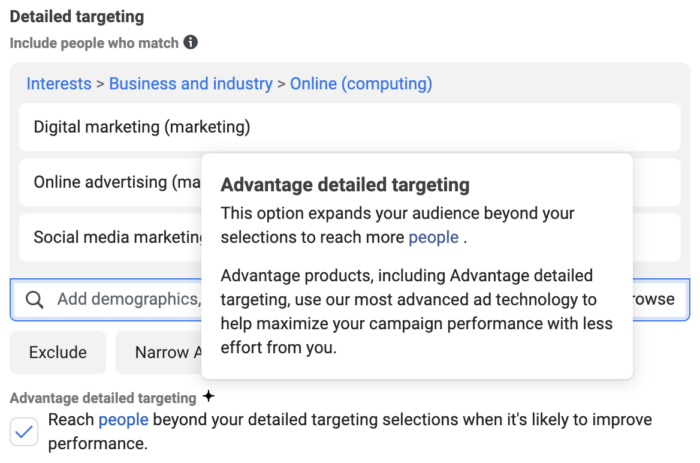
When Advantage Detailed Targeting is turned on, Meta will “dynamically expand the audience to reflect where we’re seeing better performance and we may expand your audience further to include similar opportunities.”
This expansion applies only to the Detailed Targeting (interests and behaviors) that you enter, and expansion will not impact restrictions you apply related to location, age, gender, or exclusions.
In the example above, there is a checkbox that allows the advertiser the option of turning it on and off. But it is automatically on (and can’t be turned off) when optimizing for any type of conversion, value, app event, or app install.
In these cases, it will look like this (no checkbox)…
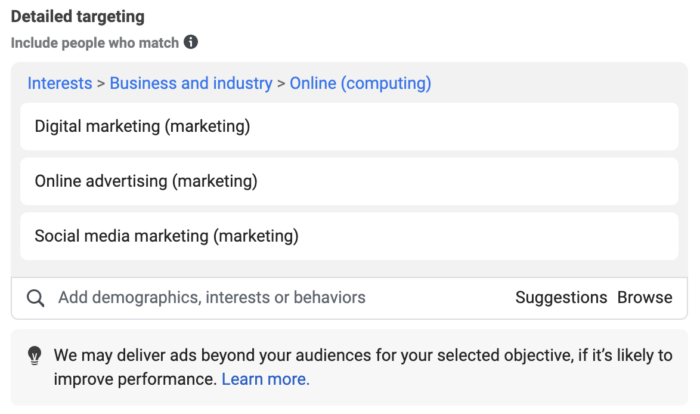
Advantage LookalikeWhen turned on, Meta can expand your audience if it believes you can get better results by doing so. That expansion will be achieved by increasing the percentage of your lookalike audience, using the original custom audience for training. More
Advantage Lookalike (originally Lookalike Expansion) came next.
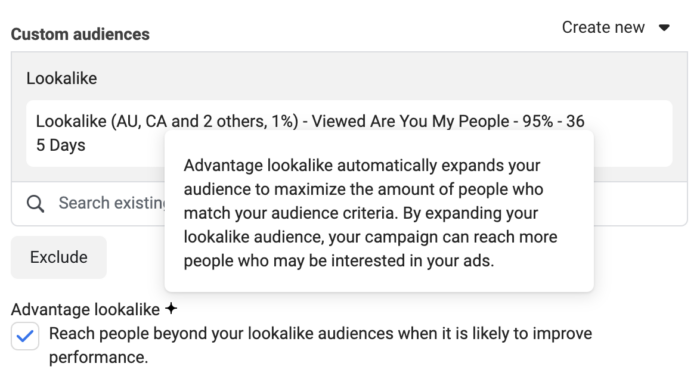
While the audience expansion concept is the same as Advantage Detailed Targeting, the execution is slightly different. Using the Custom Audience that you based your lookalike audienceLookalike audiences allow advertisers to reach people who are similar to an audience of people already close to you. Lookalike audiences are based on custom Audiences, which tend to include your current customers or people who have engaged with your business. More on as a guide, Meta’s system will expand beyond the percentage you selected for your lookalike audience if it’s determined you can get better results by doing so.
Advantage Lookalike is automatically turned on for all conversion, value, and app promotion optimizations. In these cases, it looks like this…
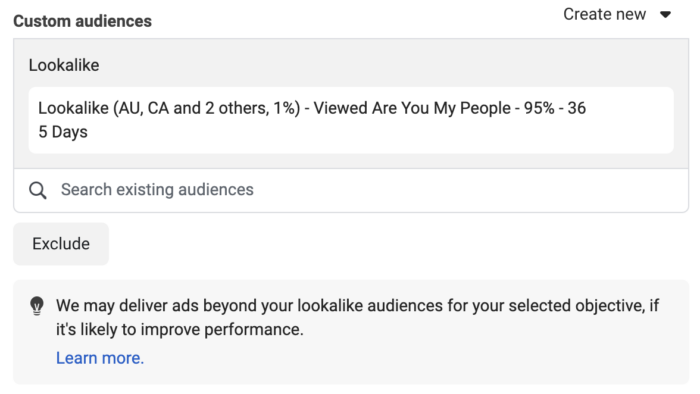
As with Advantage Detailed Targeting, the restrictions (location, age, and gender) and exclusions you set will still apply. Advantage Lookalike isn’t available for Special Ad Categories like housing, credit, employment, politics, and social issues.
Advantage Custom AudienceWhen turned on, Meta has the ability to expand targeting beyond your selected custom audience. The location, age, gender, and exclusions that you input will continue to be used as hard constraints. More
Next came Advantage Custom Audience.
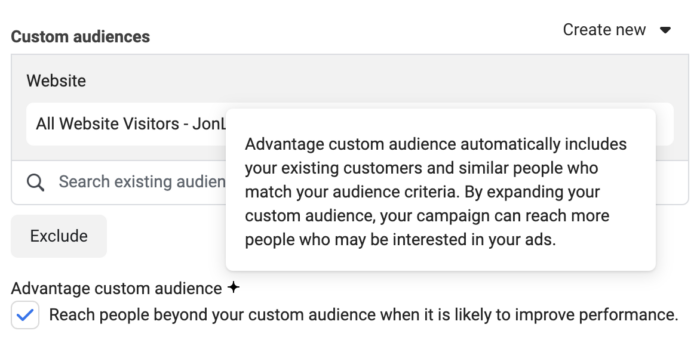
Once again, Advantage Custom Audience allows Meta to dynamically expand your audience and move beyond your selected custom audience if it’s believed that doing so can improve performance.
This feature will be turned on automatically regardless of optimizationThe Performance Goal is chosen within the ad set and determines optimization and delivery. How you optimize impacts who sees your ad. Meta will show your ad to people most likely to perform your desired action. More when a custom audience is selected. However, unlike the other two options, the checkbox remains and this option can be turned off.
This is probably good as advertisers may want to limit their targeting to a specific custom audience in some cases. But, be aware that this may be turned on — I’ve been burned by this in the past when I thought I was reaching a hyper-targeted group.
Advantage Audience
If you weren’t confused yet, it’s going to start getting confusing now…
If you select both a custom audience and lookalike audience while optimizing for a conversion or other action that won’t allow you to turn off Advantage Lookalike, it will look like this…
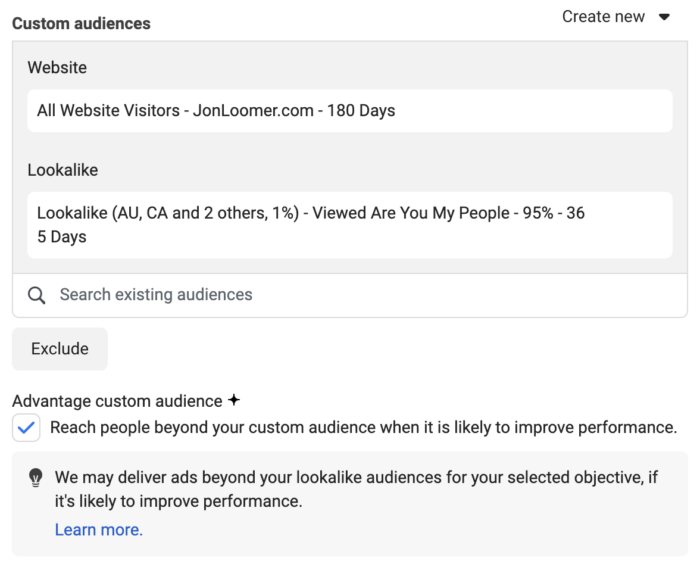
But if you optimize for an action like a link clickThe link click metric measures all clicks on links that drive users to properties on and off of Facebook. More or landing page viewLanding Page View is a Facebook ads metric that represents when people land on your destination URL after clicking a link in your ad. More (among others) where you have the ability to turn both Advantage Custom Audience and Advantage Lookalike on or off, the name changes to Advantage Audience.
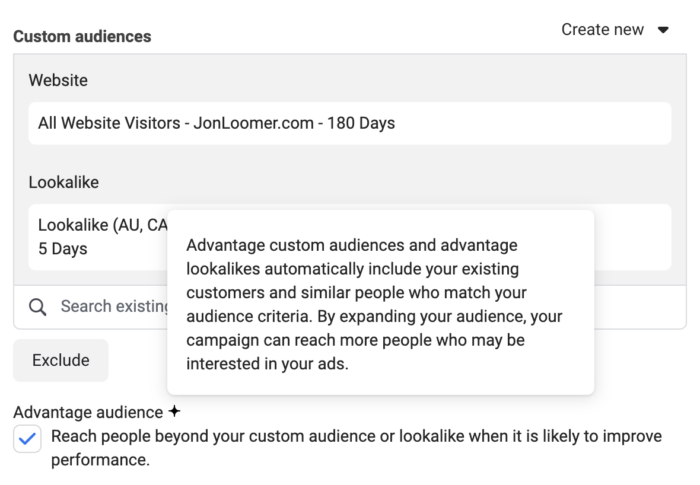
There’s no new functionality here. You just can’t individually turn Advantage Custom Audience and Advantage Lookalike on or off. It’s a group selection.
Advantage+ AudienceMeta's AI-powered targeting option. Meta will attempt to find your audience for you based on pixel activity, conversion history, and ad engagement. You can also provide targeting suggestions that Meta will initially prioritize before going broader. More
And now it’s going to get ridiculous.
Yes, it looks like I just listed Advantage Audience twice. But, this time I’m actually listing Advantage+ Audience (emphasis on the “+”). In a May 11, 2023 announcement about new AI-powered ads tools, Meta provided details about Advantage+ Audience.
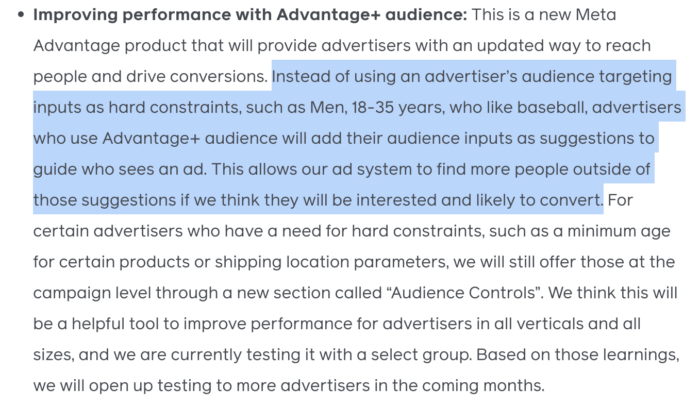
Advantage+ Audience is an AI-powered targeting tool that will develop an audience for you based on pixel activity, conversion history, and ad engagement. You have the option of providing targeting suggestions that Meta will initially prioritize. You can also use Audience ControlsAdvertisers aren't able to exclude locations or customize age targeting from directly within the ad set of an Advantage+ Shopping Campaign. But Audience Controls within the Ad Account Settings allow the ability to make these adjustments account-wide for all Advantage+ Shopping Campaigns. More as tight constraints.
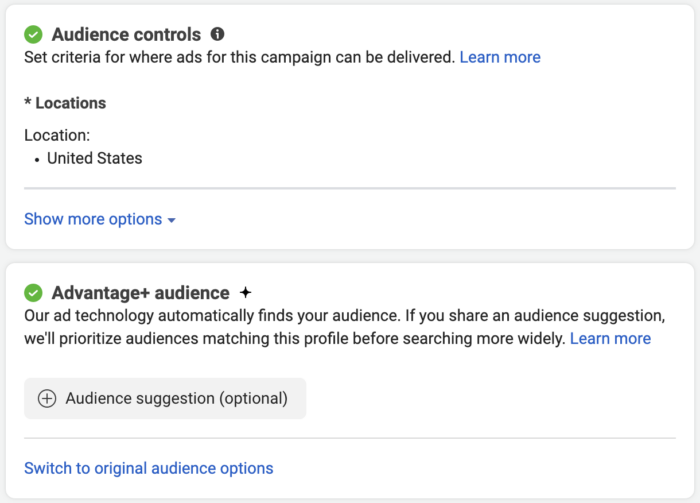
This all sounds very similar to Advantage Detailed Targeting, Advantage Lookalike, and Advantage Custom Audience, but there are slight differences.
1. Advantage+ Audience uses AI to generate your audience. This is why it includes the “+” in the name and the others do not.
2. Advantage+ Audience has the ability to go broader than the others. Meta tells us this, but it would have been difficult otherwise to know for sure since there is a lack of transparency in reporting.
3. Advantage+ Audience uses age and gender as suggestions. When turning on Advantage Detailed Targeting, Advantage Lookalike, and Advantage Custom Audience, age and gender settings are used as tight constraints.
My guess is that Advantage+ Audience will eventually replace the other three.
Should You Use Advantage Targeting?
Okay, back on topic. Let’s focus on the three actual features relevant to this post:
- Advantage Detailed Targeting
- Advantage Lookalike
- Advantage Custom Audience
- Advantage+ Audience
I was initially pretty terrified of these features. I put in certain targeting and I want to use that targeting! But with time, it’s grown on me. Expansion is that middle ground between hard constraint targeting and going broad.
The way these features are defined, targeting expansion can’t hurt you. It can only help you. The audience may not be expanded it all. But if it is, it’s because that expansion can get you better results.
The problem? We have no idea whether your audience was actually expanded, how much it was expanded, or how performance was impacted by that expansion.
There should be a pretty simple solution to this. Meta should add a breakdownBreakdown is a way to get insights into your ad performance related to time, delivery, action, or dynamic creative element. More for audience expansion that adds rows to your report for your intended audience and the expanded audience. Without that, we’re left guessing regarding whether this is actually beneficial.
More transparency could also give advertisers more confidence in these products.
Your Turn
What’s your experience been with Advantage targeting expansion products?
Let me know in the comments below!







